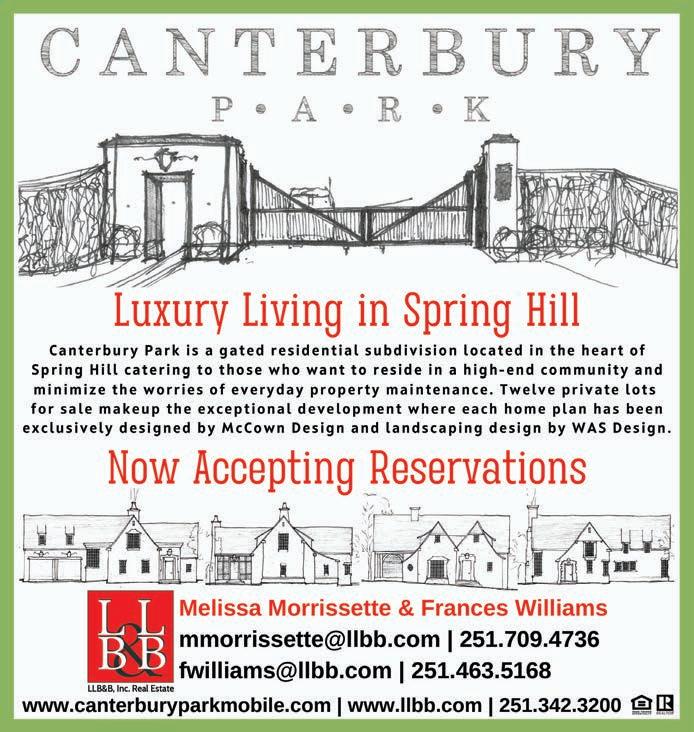
8 minute read
LEGENDS
HISTORY | LEGENDS
Love, Scandal and Property
Advertisement
At the death of one of Mobile’s first mayors, he had no idea that love was already brewing in the heart of his widow for another — and that a massive legal battle involving his children’s inheritance would ensue.
text by DAVID BAGWELL illustration by ANNA THORNTON
Mobile had plenty of love scandals back in French and Spanish times, often noted in the Catholic church records. But after those of us below the 31st parallel came into the United States, the earliest known scandal was between the rich merchant Philip McLoskey and the Spanish-heritage Catharine Caro Duval, widow of one of Mobile’s first “mayors,” Daniel Duval.
First Duval
On April 20, 1824, the Mobile Commercial Register ran this obituary: “DIED — On Sunday evening last, aged about 40 years, Capt. DANIEL DUVAL, late sheriff of this county. He was buried yesterday with Masonic honors. Mr. D. was a native of Rhode Island, but had resided in this vicinity for 10 or 12 years past, he was the first Sheriff of this county after the change of flag, and continued in office for nine years. He has left a wife and several small children to lament that which is to them an irreparable loss.”
But Duval was more than just sheriff. City government just after “the change of flag” was not exactly traditional. We know that in 1817, Daniel Duval was president of the Board of the City of Mobile, which today we would consider the same as mayor.
When Duval died in 1824, his widow Catharine was about 37 years old. She was one of 10 children who were raised in both Pensacola and Mobile and likely Cuba as well. Her father, Benito Caro, died in 1815, about when America was taking over Mobile, and at his death, he owned a huge chunk of downtown Mobile. His holdings, which stretched from Royal Street to the Mobile River, soon became the heart of downtown Mobile and the site of at least two banks, the major stores, a wharf and more. In 1821, Duval bought these lands from his widowed mother-in-law and from five of the eight children of Benito Caro. You don’t have to be a lawyer to see that a giant legal squabble would one day follow.
When Duval died in 1824, he believed himself to be the owner of an area bounded by Royal Street on the west, by the Mobile River on the east, by lots belonging to Lewis Judson on the north, and by lands belonging to the merchant princes James and John Innerarity and the estate of John Forbes on the south. Today, this is roughly where the Riverview Hotel, office building and attached parking garage stand.
Now McLoskey
Turning back to the same issue of the Mobile Commercial Register from 1824, the one that ran Duval’s obituary, the front page had an ad for the store of “Philip McLoskey & brother”:
“Have received as late arrivals the following Goods, which they will sell low for cash or town acceptances: Irish Linnens, in whole and half pieces, Drillings White, ditto Brown, Muslins, brown and bleasched, plattas, Brins, Lap-
pos, Musquito Netting, Dowles, Diapaer, Seerskers [seersuckers] ... Ladies’ white cotton hose, Super blue and black clothes, Black silk bandannah and flag ..., Muslin robes, ... Linnen checks, Brown shirting, cotton bagging, English & Dom. twine, Madeira wine, very superior wine. ALSO — a general assortment of GROCERIES.”
In the Church Street Graveyard, behind Mobile’s main library on Government Street, there stands a tall obelisk marking the grave of Philip McLoskey, who died in 1844 at age 55. His obituary noted that at his death he was the earliest surviving immigrant to Mobile. McLoskey was born in Ireland and came to Mobile in his early 20s — about when Spanish West Florida was becoming part of the United States — and went into business with his brother Patrick.
By about 1823, Mobile was beginning to make its mark as a major cotton port, and McLoskey was and had been a director of the Bank of Mobile. In 1836, he formed and was president of the Planters and Merchants Bank and built its beautiful building, which burned on October 9, 1839, in the great fire that took 1,300 Mobile buildings. McLoskey’s bank, however, had a fireproof vault.
McLoskey and a man named John Hagan then formed a partnership, and according to a contemporary, their “house did the largest business in Mobile in buying cotton, shipping and importing,” and they were “buyers and importers of fine wines.” They traded with Brown Brothers & Company of New York, one of the largest international merchant banking houses in the U.S. in the 19th century. The McLoskey & Hagan buildings were on the north side of Conti and east of Royal Street.
Unfortunately, after the fire of 1837 and the panic of 1839, the Planter’s and Merchant’s Bank failed in 1842. A stockholder’s committee listed as causes extravagant loans to individuals, monetary stringency at the time, excessive salaries paid to bank officers, stiff annual fees paid to the state and more.
And to the affair
At some time after Duval’s death in 1824, his widow Catharine and Philip McLoskey commenced an affair that lasted until she died in her 40s in Cuba. This affair spanned six or seven years and produced four illegitimate children, to whom McLoskey gave his name in his will.
Upon Catharine’s death, McLoskey retained all her property, including the tracts of land in downtown Mobile that Catharine’s deceased husband Duval purchased from (some of) her family. The



grown children of Catharine and Daniel Duval were outraged, and the matter led to litigation by the Duval children against McLoskey, litigation which raged for decades, ending only with McLoskey’s death in 1844. The suits both at law and in equity were intensely complicated and led to at least two appeals to the Alabama Supreme Court. McLoskey’s lawyer was John Archibald Campbell of Mobile, after whom the Federal Courthouse in Mobile is named and who served on the U.S. Supreme Court from 1853 to the secession of Alabama in 1861. Campbell conveniently had his office in the McLoskey & Hagan buildings.
The McLoskey / Duval litigation is oddly prescient of Campbell’s famous Myra Clark Gaines litigation in New Orleans, involving most of the land in downtown New Orleans west of the French Quarter — both cases involving rich Irish merchantmen and beautiful Latin women and arguable and mysterious relationships between them.
In the Mobile litigation, the Duval heirs claimed that McLoskey cheated them out of the downtown Mobile lands which, they said, rightfully should have been theirs. McLoskey’s version, on the other hand, signed by him and sworn on April 5, 1844, only four months before he died, denied any undue influence on or fraudulent procurement from Catharine Duval, “but on the contrary says that he has appropriated very large sums of money which belonged to him to the use of said Catharine Duval, and through her to her children who were left by their father in circumstances of great necessity, and without the means necessary to maintain and educate them ...”
There are several mysteries about all this, which we cannot quite divine two centuries later.
First, why didn’t McLoskey and Catharine marry? We just don’t know. Some have speculated that maybe he had been married to somebody else earlier, and that was a hindrance. But we don’t know.
Second, did the people of Mobile know about the affair and the children? Probably not. For one thing, Catholic Bishop Michael Portier agreed to be McLoskey’s executor. For another, McLoskey’s contemporary, Paul Ravesies, wrote in his book “Scenes And Settlers Of Alabama” that McLoskey and his business partner Hagan “often participated in Spring Hill hospitality” and “were both noted for a high order of business capacity and enlarged generosity.” It is just hard to imagine that this would be the situation if it had been known that McLoskey and Duval’s widow had had four children out of wedlock.
Third, why was Catharine in Cuba when she died, and why did she stay there from about 1828 until her death two or three years later? That was an issue litigated for some time, when the Duval heirs sued McLoskey over their grandmother’s and mother’s former property. The Duval children claimed in the litigation that McLoskey sent Catharine to Cuba and that she “was detained by duress in Cuba, whither she had been fraudulently sent, in order that the property might be sacrificed” to McLoskey.
McLoskey’s version on the other hand, signed by him, denied “that he sent the said Catharine to Cuba for that purpose except to promote her own benefit, and respectability — that no pecuniary motives induced him to desire her residence there, and he denies all duress in keeping her there.” In other words, that Catharine was again pregnant.
McLoskey’s last years must have been difficult; he was troubled by the litigation, and most of his fortune had died either in the fire of 1837 or the panic of 1839 or both or in the litigation itself. He died on August 13, 1844, at age 55, and is buried in the Church Street Graveyard in an ironfenced parcel. MB
David Bagwell is a retired attorney and amateur historian living on the Eastern Shore.












